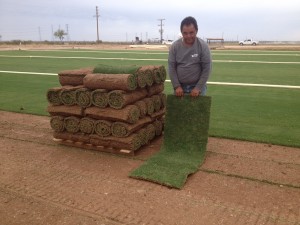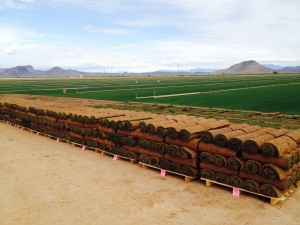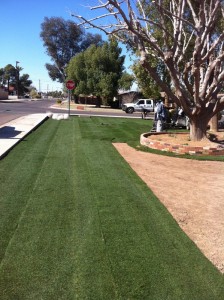May
Soil Prep/Lawn Establishment
With the rising temperatures we have quickly entered the best time of the year to plant sod. I’m sure a few of you just read the first sentence and thought that I was crazy since we’re hitting 105-110 degrees most days. Warm season turf is so well adapted to this type of weather that establishing a lawn during the summer is a simple process with the right prep work and follow up. I’m going to outline some simple cost effective steps for those looking to put in a lawn this summer.
Living in the desert we all know that water is scarce so we want to do our best to preserve it and not overuse it. One of the best water saving tips is putting in an automatic sprinkler system. Before I proceed I will tell you that I don’t recommend putting in a new lawn without one. A good sprinkler system will allow you to put out the correct amount of water in a given period of time and will help eliminate waste.
Setting up a manual sprinkler or hose is inefficient, time consuming, and most of all it is very tough to gauge the amount of water you actually put out. Before putting in an irrigation system you should by a small gauge to check your homes water pressure. Knowing how much water pressure you have will determine how many sprinklers can be on each valve. Depending on the area you will be watering you may need a couple to several valves to correctly operate your irrigation system. Most sprinkler systems are set up with a valve that controls the drip lines to the plants and then a valve for each section of the turf. A home with 1000 square feet of turf will typically have two valves to control the lawn. If you have very low water pressure you will probably need to add a third valve so less sprinklers are running at one time.
Soil Prep
As you plan for putting in a new lawn you want to make sure you budget enough time to do the correct soil prep. I’m going to put some basic steps in that everyone should follow before ordering your BOBSod or other West Coast Turf varieties.
1. Apply gypsum at 25-50 pounds per 1000 square feet to the area you will be getting ready for turf.
2. Rototill your soil to a 6-8 inch depth. This may not be possible in all areas but tilling up the soil as deep as you can will provide your lawn with more air, better water infiltration/percolation, and will allow for a stronger root structure.
3. Level and grade the soil to reestablish uniformity in the soil.
4. Install your irrigation system. It is important to make sure that all irrigation trenches are water packed and have fully settled before you put your lawn in. You don’t want to see where all the irrigation trenches were dug.
5. Finish grade your soil and use sand to do any leveling to the soil surface. Mulch is okay but it will hold moisture in the top couple inches of the soil and can potentially bring in weed seed.
6. Water your soil for a few days to make sure the soil is settled and you’re happy with the final grade. Remember sod is just like carpet and anything under the grass like large rocks will be visible.
7. Order your BOBSod and grab a couple friends to help to install the turf. Don’t forget to order your Soil Burst 5-15-10 starter fertilizer from us that can be applied right before the sod goes down or right on top of your new lawn. Don’t miss this critical step.
Installing Your West Coast Turf
1. Lay sod around the perimeter using small cuts in the sod to help wrap around tight corners.
2. Find the longest and straightest point in your lawn and lay the sod in a straight line.
3. Now follow the straight line and sod in a brick pattern to stagger the seams. The easiest way to do this is to cut the first piece of sod in half and then lay full rolls. This will keep the seams from lining up.
Watering Your New Turf
1. Water 3-4 times a day for the first two weeks making sure you keep the foliage of the grass moist. Since roots have not been established it is not important to water more than 10-15 minutes per cycle.
2. Once the grass has rooted down (can’t be pulled up) cut your watering to one time per day for 15-20 minutes. If you have low flow sprinklers you need to water twice as long as a normal pop up sprinkler.
3. Once the lawn has been in a month cut the watering back to every other to every third day for 25-35 minutes. This will be your summer watering schedule. grass should be watered deep and infrequent to promote root growth.
My next blog will be on fixing spotting from your dogs. If you enjoy my blogs and our company service we would really appreciate you leaving us a note on our Yelp page.
By the way…..I came across an interesting article regarding the heat at this past weekend’s U of A graduation. It was on their new artificial turf football field (they replaced their award winning field last year with a plastic surface with crumb rubber). It is titled” U of A Heat Stricken Grads–We Screwed Up.” At least eight graduates were treated by paramedics for seizures, fainting and dehydration. Several guests also succumbed to the heat and a few were taken to the hospital, campus police said. An artificial turf field has been documented to be up to 86.5 degrees hotter than a natural turf field on an 81 degree day. It was over 100 degrees in Tucson.
Please let me know if you have any questions about your own lawn.
Jay
PS….. Please ‘Like” our Facebook page to keep up with all of the exciting new developments in the world of turfgrass!





